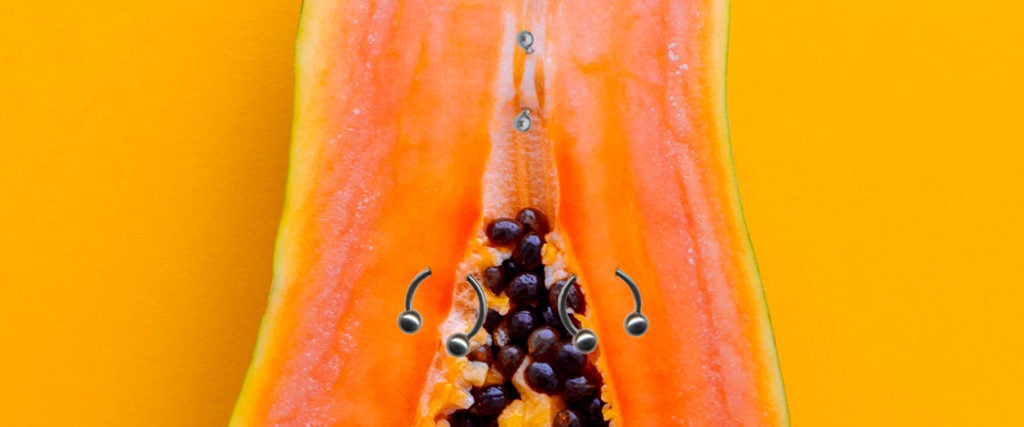There are, surprisingly, a handful of reasons to voluntarily have a needle placed through your most delicate regions. Maybe that’s obvious — why would you get a genital piercing if there weren’t some sort of gain involved, even if that gain was simply the pleasure of pain? But even relatively vanilla folks have been known to get clitoral hood piercings or Prince Alberts, simply because, well, they feel good.
According to Ryan Ouellette, member of the Association of Professional Piercers and piercer at Precision Body Arts in New Hampshire, the vertical clitoral hood (VCH) piercing and the Prince Albert are the most popular vulva and penis piercings, respectively. “During 2019, I’d say we performed five to six vulva piercings on a weekly basis, and five to six penis/scrotum piercings monthly,” he says. “That’s only a general average. There could be times when I’d perform multiple genital piercings in a day, or they would come in clusters.”
Part of the reason for the popularity of the VCH piercing in particular is that for many people, it can offer an increase in pleasure. “The VCH is relatively easy to receive and can offer both an aesthetic benefit and sexual stimulation,” says Ouellette. As the name suggests, the VCH doesn’t pierce the clit itself, but instead the protective flesh around it. Together, the clit and the clitoral hood have somewhere around 7,000 nerve endings. However, its distance from the vaginal opening can make it challenging to experience clitoral stimulation during intercourse. With the VCH, the range of exposure for the clit is increased — when the piercing is moved, the clit can be stimulated.
Like most other piercings, some genital piercings are strictly for show. A Christina piercing, for example, which is a vertical piercing on the pubic mound (kind of like a belly button piercing, but right at the top of the vulva), is there just to look cute. For penises, the Prince Albert offers something between aesthetics and pleasure. While a ring through the head of one’s penis might not enhance sensation in itself, dick piercings are a popular kink. “The Prince Albert is also a relatively-easy-to-receive piercing and is a typical ‘starter’ piercing for people interested in their first penis piercing,” Ouellette explains.
Despite the seemingly extreme nature of genital piercings, caring for them isn’t all that different from caring for any other type of piercing. “Our preferred aftercare is to cleanse the site as needed during the first few weeks with a sterile saline spray,” says Ouellette. “It’s typical for new piercings to discharge or build up a small amount of dried discharge. We suggest softening any accumulated discharge with saline then gently wiping it away with a cotton swab or gauze. We don’t suggest cleaning a healing piercing with any soap products, as soap can easily over-dry skin and healing piercings.”
Further, it’s usually recommended that the newly-pierced avoid sex for several weeks to several months, depending on the nature of the piercing. For both the VCH and Prince Albert, four to eight weeks of abstinence is recommended for the sake of healing and avoiding pain. That said, despite the wait, many people find the erotic appeal worth it: The subreddit r/PiercedCock, with more than 10,000 members, offers some examples of both the fetishization of pierced penises as well as the vast realm of possibility for multiple penis piercings. “Many clients are so pleased with their first genital piercing that they return for others in the future, especially in relation to penis/scrotum piercing clients,” says Ouellette.
Similarly, some people simply enjoy the way their vulva looks with a piercing. “For me it was more psychological,” writes one anonymous person with a VCH in an r/AskReddit thread on the topic of genital piercings. “I’ve never been comfortable with that part of my body so I decided to own it and make it mine. Best decision I ever made.”
As for Ouellete’s clients, the reasoning behind getting a genital piercing varies. “It’s really the same answer to most ‘why?’ questions. Why did you style your hair like that? Why did you eat that food? Why did you buy that car? Because they liked it and it made them feel good,” he says.
In that way, genital piercings can be a form of self-expression. “People like to claim ownership over their bodies,” Oullette offers. “Some people choose body piercing to do that. Some people find that intimate piercings enhance their sex lives or their body image. Whatever the personal motivations may be, I’m honored to help people express themselves in a safe and healthy way.”

